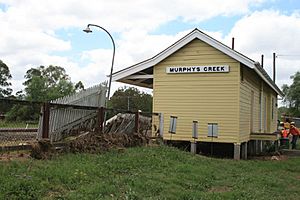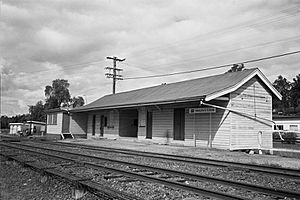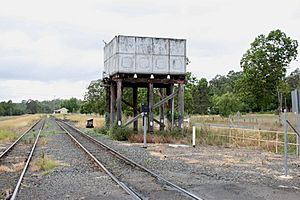Murphys Creek Railway Complex facts for kids
Quick facts for kids Murphys Creek Railway Complex |
|
|---|---|

Murphys Creek railway station, 2011
|
|
| Location | Odin Street, Murphys Creek, Queensland, Australia |
| Design period | 1840s - 1860s (mid-19th century) |
| Built | 1921 - c. 1949 |
| Official name: Murphys Creek Railway Complex, Murphys Creek Locomotive Water Tank and Tower | |
| Type | state heritage (landscape, built) |
| Designated | 24 September 1999 |
| Reference no. | 601532 |
| Significant period | 1867-1992 (historical) |
| Significant components | views to, tank - water |
| Lua error in Module:Location_map at line 420: attempt to index field 'wikibase' (a nil value). | |
The Murphys Creek Railway Complex is a special heritage-listed railway area located on Odin Street in Murphys Creek, Queensland, Australia. It was built between 1921 and around 1949. This complex is also known as the Murphys Creek Locomotive Water Tank & Tower. It was added to the Queensland Heritage Register on 24 September 1999 because of its historical importance.
Contents
A Look Back: History of the Railway
The Murphy's Creek Railway Station first opened in 1867. This happened when the railway line through the Main Range was finished. This line was part of the Southern and Western Railway, connecting Ipswich to Toowoomba. The town of Murphy's Creek grew up because of the railway station. The name Murphy's Creek comes from a creek named after a shepherd who lived in the area back in 1864.
In the early days, train engines (locomotives) couldn't carry much water. This meant they needed places to stop and refill their water tanks. These "water halts" were set up at Helidon, Murphy's Creek, and Highfields (which later became Spring Bluff). Murphy's Creek was known as a "feeding place for the engines" because it was on the tough 30-kilometre (19 mi) climb up to Toowoomba.
In 1871, a goods shed was added at Murphy's Creek to handle more goods being transported. By 1877, the railway station was getting very busy. More space was needed for trains to pass each other on the single track. So, a new booking office and platform were built, and an extra track was added. In 1879, the water supply for the locomotives was made even bigger with an 11,000 imperial gallons (50,000 L; 13,000 US gal) water tank.
In 1884, the station yard got new signals. At this time, Murphy's Creek had a station building with a telegraph connection and a place for trains to get water.
Turning Trains: The Forkline
In 1884, a special area was set aside for railway use across from the station. In 1885, a "forkline" or turning triangle was built here for locomotives. Before this, there was a turntable. The forkline was needed because early steam engines found it hard to climb the Main Range with a full load. Trains would come down from Toowoomba to help pull loads up. From the early 1900s, "banking engines" were used to help push trains up the Range from Murphy's Creek. At the same time, a timber loading bank was built to load stone from nearby quarries.
Sadly, in 1887, the ladies waiting room and the lamp room at the station were destroyed by fire. In 1913, a new signal cabin and interlocking system were installed. This helped speed up train movements on the western main line.
Water for Steam Engines
In 1917, Murphy's Creek stopped being a regular watering station. However, in August 1921, an 8,000-imperial-gallon (36,000 L; 9,600 US gal) water tank was put up for emergencies. This tank was used by train crews who needed extra water for the Main Range section.
Special water softening plants were also installed at Helidon and Murphy's Creek. These plants used lime to soften the water. This was important because hard water could cause a build-up inside the locomotive boilers, which would damage them. A sand shed was also built to store dried sand. This sand was used by engines to help them get better grip on slippery rails, especially on the steep hills and sharp curves of the Main Range. Water was pumped from the nearby creek into the storage tank using a steam pump.
By 1949, the 1921 water tank at Murphy's Creek was made twice as big by adding a second level. The biggest water tank on a Queensland steam locomotive could hold 3,500 imperial gallons (16,000 L; 4,200 US gal), so the Murphy's Creek tank held about three times that amount!
The End of the Steam Era
The importance of Murphy's Creek as a station began to fade in 1952. This was when new diesel-electric trains were introduced. By June 1956, all services between Brisbane and Toowoomba were using diesel engines. Diesel engines didn't need to stop for water as often, and they were much more powerful. This meant they didn't need extra engines to help push trains up the range.
In 1963, the raised timber platform at Murphy's Creek station was removed and replaced with a gravel platform at ground level. A new signal cabin was also added. Steam train operations on the Main Range stopped completely by the mid-1960s.
The Murphy's Creek railway station officially closed in 1992. This happened when a new computerised system called Centralised Traffic Control (CTC) was introduced. This modern system made the old mechanical signals and staff working methods unnecessary. The station and its buildings were sold to the local Murphy's Creek Progress Association in 1993. The large water tank continued to be used by the local town for water supply and as an emergency water source during bushfires. Queensland Railways kept the water tank for special steam train trips, but it was taken out of use in 1994.
What You Can See Today
The Murphy's Creek Railway Complex includes a station building, a signal cabin, a large water tank, a trolley shed, and a forkline. Most of the complex is within the railway area. The forkline is located a bit further away, across Odin Street. A crossing loop track runs along the station area.
The Station Building
The Murphy's Creek Station building is a single-storey wooden structure. It's located in the middle of a platform that faces north-east. The building is made of timber and covered with special wooden boards called chamferboards. It has a gabled roof made of corrugated iron, which extends over the platform, supported by wooden brackets.
The building has two main parts, separated by an open shelter area in the middle. Both parts have windows and two wooden doors that lead into the rooms from the platform.
The Signal Cabin
The signal cabin is a small, separate wooden building with a sloping roof. It's located near the station building. The cabin is covered with weatherboards and sits on a concrete base. It has glass louvre windows and a door on one side. A small corrugated iron water tank on wooden stumps sits behind the building.
The Trolley Shed
About 25 metres (82 ft) east of the platform, you'll find the trolley shed. This rectangular shed is covered in unpainted corrugated iron and has a sloping roof. The front of the shed has three sections, each with double doors that open outwards.
The Water Tank
The Murphy's Creek water tank is about 120 metres (390 ft) north-west of the railway station. This huge water tank is made of cast iron. The original 8,000-imperial-gallon (36,000 L; 9,600 US gal) tank from 1921 forms the bottom part, and a second level was added later to double its storage. The lower part has decorative designs on its iron panels. The tank stands high above the ground on a timber frame, which is about 6 metres (20 ft) tall. This frame is made of 10 strong hardwood posts that are braced together. These posts have inspection dates marked on them, showing when they were checked and maintained.
The tank has internal and external bracing to make it strong. Unlike some other old water tanks, the Murphy's Creek tank has a special "water jib" or crane. This crane was used to quickly deliver water to steam locomotives. An electric pump now fills the tank from the main water supply. The swing jib is located on the side of the tank facing the main railway line. It was used to deliver water through a gravity-fed pipe system into the water tank of a steam locomotive. A canvas hose helped direct the water flow. A ladder on the side of the tank allows access for maintenance. There's also a light to illuminate the area at night.
Near the base of the tank, you can see three concrete blocks. These used to support the water softening plant, which has now been removed. A wooden sandbox, used to refill sandboxes on diesel-electric locomotives, is also located next to the tank.
The Forkline
Branching off from the main railway line, between the station building and the water tank, is a turning triangle or forkline. This is a raised track area in a large grassy space. This forkline allowed locomotives to turn around. It crosses Odin Street and then curves to the south, ending at a stop block. To the west, it ends at a raised concrete loading bank. The triangle shape is formed by a section of track that connects the southern and western parts before they end.
Why It's Important: Heritage Listing
The Murphys Creek Railway Complex was added to the Queensland Heritage Register on 24 September 1999 because it meets several important criteria:
It shows how Queensland's history developed. The Murphy's Creek Railway Complex is important because it shows how transport changed in Queensland. It highlights the growth of Queensland's Railways during the steam locomotive era, from 1865 to 1969. Providing water to locomotives on the Main Range Railway was a very important part of the journey. The Murphy's Creek Railway Station was built specifically because it was needed as a watering stop.
It shows rare or endangered parts of Queensland's history. The Murphy's Creek Water Tank is a rare and still working water tank. It was used to refill steam locomotives on the Main Range railway. Water tanks were once a common and vital part of railway systems in Queensland. However, most of them have been taken down, sold, or moved. This tank was kept by Queensland Rail to supply water for special steam train trips until 1994.
It shows the main features of a certain type of historical place. With its water tank, forkline, station building, signal cabin, and trolley shed, the Murphy's Creek Railway Complex helps us understand how steam locomotives and trains operated on the Main Range Railway for nearly a century. It reminds us of how these types of engines worked and were maintained.
Images for kids





